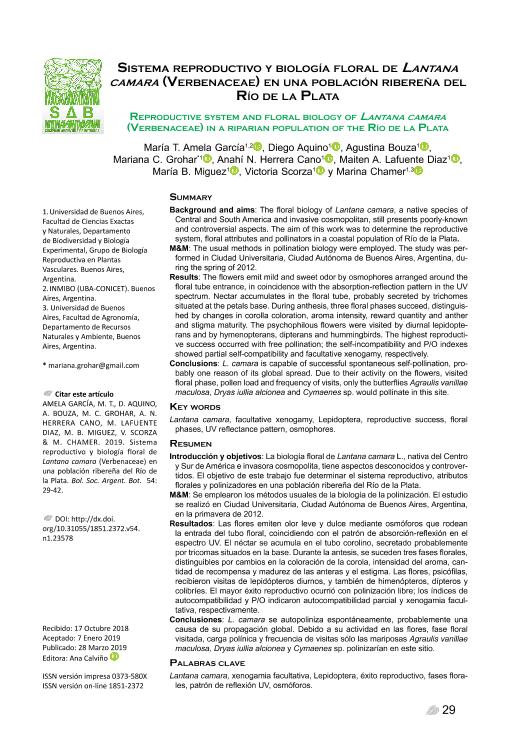Artículo
Introducción y objetivos: La biología floral de Lantana camara L., nativa del Centro y Sur de América e invasora cosmopolita, tiene aspectos desconocidos y controvertidos. El objetivo de este trabajo fue determinar el sistema reproductivo, atributos florales y polinizadores en una población ribereña del Río de la Plata.M&M: Se emplearon los métodos usuales de la biología de la polinización. El estudio se realizó en Ciudad Universitaria, Ciudad Autónoma de Buenos Aires, Argentina, en la primavera de 2012.Resultados: Las flores emiten olor leve y dulce mediante osmóforos que rodeanla entrada del tubo floral, coincidiendo con el patrón de absorción-reflexión en el espectro UV. El néctar se acumula en el tubo corolino, secretado probablemente por tricomas situados en la base. Durante la antesis, se suceden tres fases florales, distinguibles por cambios en la coloración de la corola, intensidad del aroma, cantidad de recompensa y madurez de las anteras y el estigma. Las flores, psicófilas, recibieron visitas de lepidópteros diurnos, y también de himenópteros, dípteros y colibríes. El mayor éxito reproductivo ocurrió con polinización libre; los índices de autocompatibilidad y P/O indicaron autocompatibilidad parcial y xenogamia facultativa, respectivamente.Conclusiones: L. camara se autopoliniza espontáneamente, probablemente unacausa de su propagación global. Debido a su actividad en las flores, fase floralvisitada, carga polínica y frecuencia de visitas sólo las mariposas Agraulis vanillae maculosa, Dryas iullia alcionea y Cymaenes sp. polinizarían en este sitio. Background and aims: The floral biology of Lantana camara, a native species of Central and South America and invasive cosmopolitan, still presents poorly-known and controversial aspects. The aim of this work was to determine the reproductive system, floral attributes and pollinators in a coastal population of Río de la Plata. M&M: The usual methods in pollination biology were employed. The study was performed in Ciudad Universitaria, Ciudad Autónoma de Buenos Aires, Argentina, during the spring of 2012. Results: The flowers emit mild and sweet odor by osmophores arranged around the floral tube entrance, in coincidence with the absorption-reflection pattern in the UV spectrum. Nectar accumulates in the floral tube, probably secreted by trichomes situated at the petals base. During anthesis, three floral phases succeed, distinguished by changes in corolla coloration, aroma intensity, reward quantity and anther and stigma maturity. The psychophilous flowers were visited by diurnal lepidopterans and by hymenopterans, dipterans and hummingbirds. The highest reproductive success occurred with free pollination; the self-incompatibility and P/O indexes showed partial self-compatibility and facultative xenogamy, respectively. Conclusions: L. camara is capable of successful spontaneous self-pollination, probably one reason of its global spread. Due to their activity on the flowers, visited floral phase, pollen load and frequency of visits, only the butterflies Agraulis vanillae maculosa, Dryas iullia alcionea and Cymaenes sp. would pollinate in this site.
Sistema reproductivo y biología floral de Lantana camara (Verbenaceae) en una población ribereña del Río de la Plata
Título:
Reproductive system and floral biology of Lantana camara (Verbenaceae) in a riparian population of the Río de la Plata
Amela Garcia, Maria Teresa ; Aquino, Diego Sebastián
; Aquino, Diego Sebastián ; Bouza, Agustina; Grohar, Mariana Cecilia
; Bouza, Agustina; Grohar, Mariana Cecilia ; Herrera Cano, Anahí Naymé
; Herrera Cano, Anahí Naymé ; Lafuente Diaz, Maiten Amalia
; Lafuente Diaz, Maiten Amalia ; Miguez, María Belén
; Miguez, María Belén ; Scorza, María Victoria
; Scorza, María Victoria ; Chamer, Ana Marina
; Chamer, Ana Marina
 ; Aquino, Diego Sebastián
; Aquino, Diego Sebastián ; Bouza, Agustina; Grohar, Mariana Cecilia
; Bouza, Agustina; Grohar, Mariana Cecilia ; Herrera Cano, Anahí Naymé
; Herrera Cano, Anahí Naymé ; Lafuente Diaz, Maiten Amalia
; Lafuente Diaz, Maiten Amalia ; Miguez, María Belén
; Miguez, María Belén ; Scorza, María Victoria
; Scorza, María Victoria ; Chamer, Ana Marina
; Chamer, Ana Marina
Fecha de publicación:
03/2019
Editorial:
Sociedad Argentina de Botánica
Revista:
Boletín de la Sociedad Argentina de Botánica
ISSN:
0373-580X
e-ISSN:
1851-2372
Idioma:
Español
Tipo de recurso:
Artículo publicado
Clasificación temática:
Resumen
Archivos asociados
Licencia
Identificadores
Colecciones
Articulos(CEFYBO)
Articulos de CENTRO DE ESTUDIOS FARMACOLOGICOS Y BOTANICOS
Articulos de CENTRO DE ESTUDIOS FARMACOLOGICOS Y BOTANICOS
Articulos(IBBEA)
Articulos de INSTITUTO DE BIODIVERSIDAD Y BIOLOGIA EXPERIMENTAL Y APLICADA
Articulos de INSTITUTO DE BIODIVERSIDAD Y BIOLOGIA EXPERIMENTAL Y APLICADA
Articulos(INMIBO (EX - PROPLAME))
Articulos de INSTITUTO DE MICOLOGIA Y BOTANICA
Articulos de INSTITUTO DE MICOLOGIA Y BOTANICA
Articulos(MACNBR)
Articulos de MUSEO ARG.DE CS.NAT "BERNARDINO RIVADAVIA"
Articulos de MUSEO ARG.DE CS.NAT "BERNARDINO RIVADAVIA"
Citación
Amela Garcia, Maria Teresa; Aquino, Diego Sebastián; Bouza, Agustina; Grohar, Mariana Cecilia; Herrera Cano, Anahí Naymé; et al.; Sistema reproductivo y biología floral de Lantana camara (Verbenaceae) en una población ribereña del Río de la Plata; Sociedad Argentina de Botánica; Boletín de la Sociedad Argentina de Botánica; 54; 1; 3-2019; 29-42
Compartir
Altmétricas



